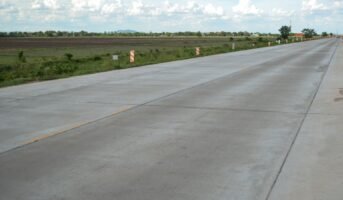Bitumen roads are among the most commonly used types of roads worldwide, and they are known for their durability and resilience. Bitumen, also known as asphalt, is a sticky and highly viscous liquid that is mixed with other materials to create a strong and long-lasting road surface. This article will help you understand the purpose and construction of bitumen roads better.
See also: Concrete roads: Know types and benefits
Bitumen road: What is it?

Source: Pinterest
Bitumen road is a type of pavement made from bitumen, which is a highly viscous, black, sticky and dense form of petroleum. Bitumen is mixed with aggregates, such as gravel or crushed rock, and then laid down on a prepared surface to form a road.
The construction of a bitumen road typically involves several layers of materials, including a sub-base layer, a base layer, and a wearing course layer. The sub-base layer provides support for the road, the base layer provides additional strength, and the wearing course layer is the visible surface that vehicles drive on.
Bitumen roads are commonly used for highways, urban roads, and airport runways due to their durability, resistance to water and weathering, and ability to withstand heavy traffic loads. They are also relatively easy and cost-effective to construct and maintain compared to other types of roads.
Bitumen road: Characteristics

Source: Pinterest
Bitumen roads have several key characteristics, including:
- Durability: Bitumen roads are highly durable and can withstand heavy traffic loads, making them ideal for use in highways and busy urban areas.
- Resistance to weathering: Bitumen is highly resistant to weathering and can withstand exposure to extreme temperatures, rain, and snow without cracking or breaking down.
- Low maintenance: Bitumen roads require relatively little maintenance compared to other types of roads. They can be easily repaired and resurfaced when necessary.
- Skid resistance: The surface of a bitumen road can be designed to provide good skid resistance, which is important for safety when driving on wet or slippery surfaces.
- Noise reduction: Bitumen roads are relatively quiet compared to other types of roads, which is important for reducing noise pollution in urban areas.
- Smoothness: Bitumen roads can be constructed to provide a smooth driving surface, which is important for comfort and safety.
- Cost-effective: Bitumen roads are often more cost-effective to construct and maintain compared to other types of roads, making them a popular choice for many applications.
Bitumen road: Construction

Source: Pinterest
The construction of a bitumen road typically involves the following steps:
- Preparation of the subgrade: The subgrade is the natural ground surface of the road that will be built. It needs to be cleared of any debris and graded to ensure a uniform surface. Any soft or unstable areas should be removed and replaced with suitable material to create a stable base.
- Placement of the sub-base: The subbase layer is added to provide a stable base for the road. This layer can be made up of crushed stone or other suitable materials, and it is typically compacted to ensure a uniform surface.
- Placement of the base course: The base course is added to provide additional strength and support to the road. This layer can also be made up of crushed stone or other suitable materials, and it is also compacted to ensure a uniform surface.
- Placement of the bitumen: The bitumen is heated to a liquid state and then mixed with aggregates such as gravel, crushed rock, or sand to create the asphalt mix. The mix is transported to the construction site and spread over the base course in a uniform layer using a paver machine.
- Compaction: The asphalt mix is compacted using a roller to ensure a smooth surface and good adhesion between the layers.
- Surface treatment: A layer of bitumen emulsion or asphalt cement is applied to the surface of the road to protect it from water and weathering.
- Finishing: The surface is then finished using a mechanical broom or other equipment to ensure a uniform texture and good skid resistance.
FAQs
What is bitumen and how is it made?
Bitumen is a black, sticky, and highly viscous liquid that is derived from crude oil. It is made by distilling crude oil and then removing the lighter fractions, leaving the heavy, dense bitumen behind. The remaining bitumen is further processed to improve its quality and suitability for use in road construction.
How long do bitumen roads last?
The lifespan of a bitumen road depends on various factors, including the quality of the materials used, the design of the road, the volume of traffic, and the climate. In general, a well-constructed and maintained bitumen road can last up to 20 years or more.
How are bitumen roads constructed?
Bitumen roads are constructed in several layers, including a sub-base, base course, binder course, and wearing course. The sub-base and base course provide a stable foundation for the road, while the binder and wearing courses provide a smooth and durable road surface. The layers are typically laid using specialised equipment, such as pavers and compactors.
How are bitumen roads maintained?
Regular maintenance is essential to ensure the longevity and safety of bitumen roads. Maintenance activities include filling potholes, repairing cracks, and resurfacing worn or damaged sections of the road. The frequency and extent of maintenance depend on various factors, such as the volume of traffic and the climate.
| Got any questions or point of view on our article? We would love to hear from you.
Write to our Editor-in-Chief Jhumur Ghosh at [email protected] |
Housing News Desk is the news desk of leading online real estate portal, Housing.com. Housing News Desk focuses on a variety of topics such as real estate laws, taxes, current news, property trends, home loans, rentals, décor, green homes, home improvement, etc. The main objective of the news desk, is to cover the real estate sector from the perspective of providing information that is useful to the end-user.
Facebook: https://www.facebook.com/housing.com/
Twitter: https://twitter.com/Housing
Email: [email protected]











